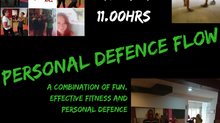HIIT, VIIT or HVIT.....what does it all mean?
- Ian
- Jan 23, 2018
- 4 min read
Question - What’s the best conditioning training method for martial arts?
Without getting too deep into the rationale right away, the best for of training for martial arts is indeed to practice martial arts! It is obvious right? More time spent doing the activity you are going to engage in will allow your body to make adaptations which result in you becoming more efficient in performance of this activity, This is the principle of specificity. Your body will adapt specifically to the demands you specifically impose on it.

However, it is also widely agreed (and proven) that improving your strength and conditioning will produce generalised improvements to your game too. Increased capacity to manage load, generate power and improved muscular endurance can all be gained through coupling your specific training, with an informed and balanced strength and conditioning programme.
For many strength and conditioning coaches the default conditioning programme is HIIT. High Intensity Interval Training is considered to be the provide optimal results as it more closely mirrors and matches the type of explosive activity performed within the martial arts. However, HIIT training is often a very misunderstood term and whilst done correctly it can yield spectacular results, the very nature of this type of training increases risk of injury and overtraining.
HIIT training (or as we will see what is considered HIIT) is now mainstream in the fitness industry. Every street corner gym is marketing the next work out of the day, HIIT programme which claims to provide maximal results in the minimum amount of time. Derived from an training approach with the sports conditioning arena, true HIIT seeks to work the participant at a near maximal level of performance across a relatively low volume of intervals. Between each interval is a significant rest period to allow for optimal body mechanics and performance within the periods of work.

The point here is that HIIT, true HIIT, is a short duration, low volume approach to training. Working a maximal levels of performance (and there’s a difference to be made here between maximal exertion (how you feel) and maximal performance (what your body can deliver maximally)) cannot be sustained for long periods of work, or indeed across a volume of intervals, without placing the participant at risk of injury. Moreover, by forcing the body to work maximally when it is being fatigued to this level will only result in poor movement patterns, which as well as being potentially injurious, detract from the specific bio-mechanical improvement and efficiencies required.
In reality a large amount of popular HIIT programmes are not this at all. They largely fall into one of two categories VIIT (variable intensity interval training) or HVIT (high volume interval training).
VIIT profiles changes to intensity throughout the overall training session. In VIIT training a participant may be required to undertake intervals of maximal performance, followed by active rest, followed by intervals of sub-maximal performance. This type of training allows for development of power and explosiveness, as well as developing an underpinning capacity for muscular endurance and aerobic fitness.
HVIT is often where programmes land as a result of misinformation and misguided coaching. HVIT programmes are characterised by a substantial number of work intervals, minimal rest periods and an expectation that the work intervals will be completed at a consistently high speed/intensity. Without going into minute detail concerning the rate of recovery of the anaerobic energy systems within the body, let’s just agree that this expectation is somewhat flawed. Without adequate rest the body cannot recover fully. When working at a high level of performance, the anaerobic energy systems within the body will get rapidly depleted. This will result in physiological changes which lead to decreases in the levels of actual performance (for example, increases in lactate levels) . Across the HVIT programme then the participant may feel that they are continuing to work maximally, but unfortunately this is a question of perception (maximal exertion) over reality (maximal performance). Equally the HVIT approach loaded with intervals completed as hard as possible in the shortest time, opens the door to over training and overuse injuries.
So...whilst many trainers cling to the perception that harder is better and indeed conditioning for martial arts centres around the “no pain, no gain” cliche, nothing could be further from the actual truth. Martial arts and combat sports are not activities of maximal exertion. Yes as martial artists we need the ability to generate explosive movement and maximal power, however there is no a necessity to maintain this delivery over an extended duration. In fact a cursory study of any combat sports will show you that even here there are periods of high intensity work, interspersed with periods of lower intensity, submaximal work. Committing participants to a HVIT approach (as many under informed trainers do) is not only misguided, it is wholly counter productive.

The optimal method for strength and conditioning in our opinion lies in the VIIT approach. Understanding that the game we play, the activity we do, has a requirement for muscular endurance (performance overtime) and periods of maximal exertion, will naturally land us in the arena of VIIT. Additionally the VIIT approach provides the participant an opportunity to actively recover within the session. This in turn potentially allows for the delivery of more high quality, high intensity intervals which are fundamental in regards to ensuring our ancillary training provides for and supports the primary goal - to be a better martial artist.
Our active combat training programme is a VIIT conditioning programme uniquely designed by martial artists. It supports both the premise of specificity in regards to the activity undertaken and allows for effective development of explosive power and muscular endurance. For more information contact us today!

















































Comments